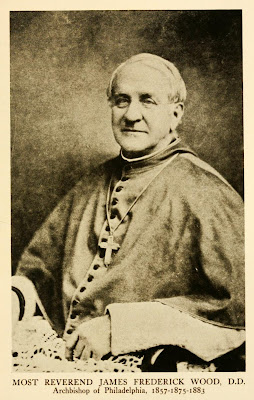In Cincinnati, the young man befriended Bishop John Purcell, who encouraged his interest in Catholicism. In 1836, Wood was received into the Church. Within a few months he quit his job and sailed for Rome. There he studied for the priesthood and was ordained in 1844. Back in America, his banking experience would serve him well as a pastor and administrator. One historian writes that Wood “was acknowledged by the financial world as thoroughly acquainted with ever phase of the banking business.”
In February 1857, Father Wood was named a bishop to assist St. John Neumann in Philadelphia. (It was said of Neumann that he “was an apostle, not an administrator.” The latter was Wood’s strength.) In 1860, he succeeded Neumann as bishop of whatw as then the largest American diocese, covering all of Pennsylvania and Delaware. Reserved and private, Bishop Wood was called “the shadow,” but he was one of those bishops whose accomplishments spoke much.
Under Bishop Wood, Philadelphia became one of America’s best organized dioceses. A sizeable network of parishes, schools, hospitals and orphanages was expanded and developed; new religious orders of men and women arrived; vocations grew and immigration increased the Catholic population. Two of his most significant legacies are the Cathedral of Saints Peter and Paul, which he completed in 1864, and moving St. Charles Borromeo Seminary to its current location in Overbrook.
In 1868, at his request, three new dioceses were created in Pennsylvania and Delaware: Harrisburg, Scranton, and Wilmington. In 1875, Philadelphia was raised to archdiocesan status, and Wood was made its first archbishop. Plagued by rheumatism and Bright’s disease in his later years, he spent much of his time in Florida. At the time of his death, he was hailed as one of the city’s “most beloved sons.”












